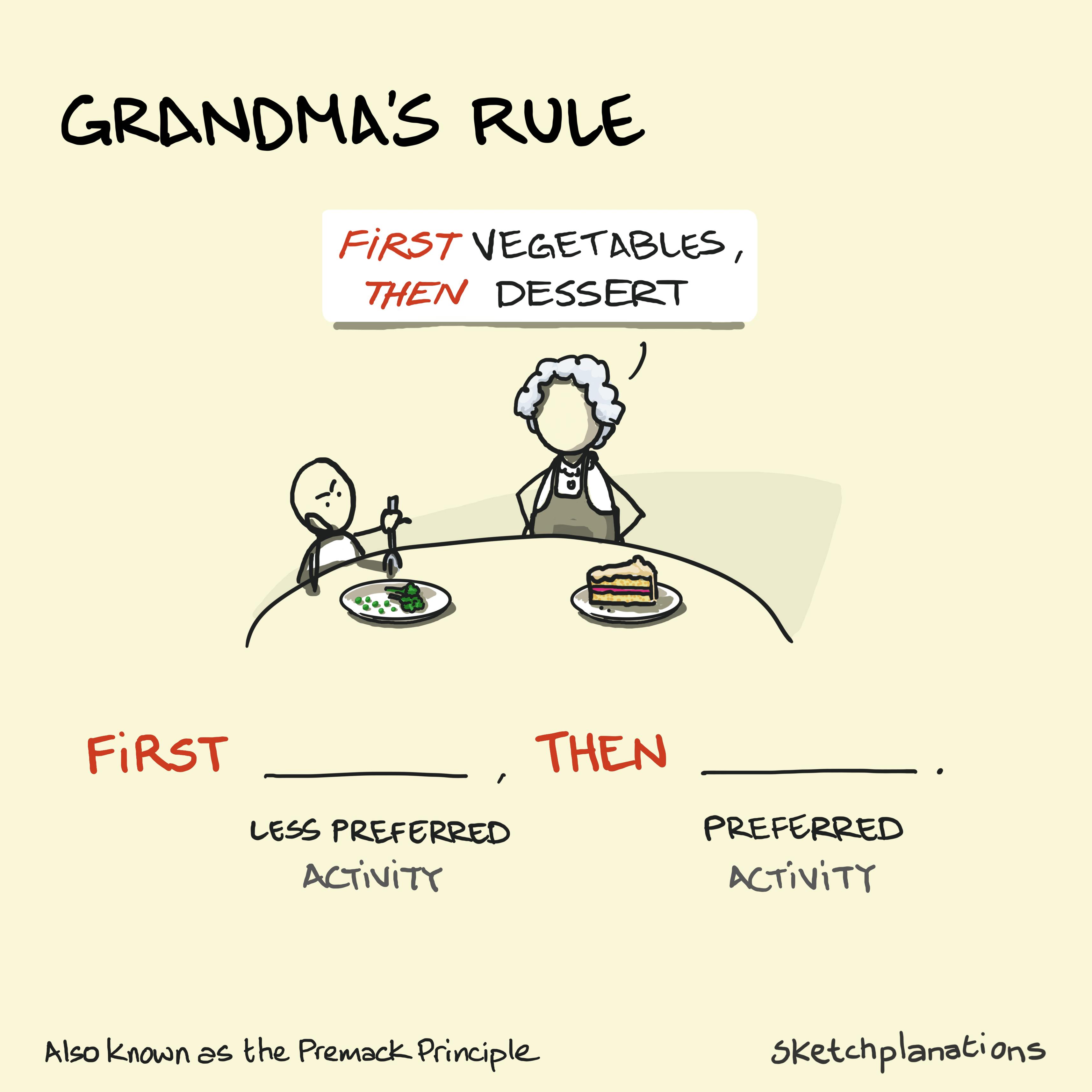Grandma's Rule: First___, Then___

- Prints
- Copied!
👇 Get new sketches each week
It's not clear to me whether the familiar childhood refrain of "First eat your vegetables, and then you can have dessert," is borne out of desperation or generational experience. As a parent myself, I'd hazard desperation, but perhaps I was simply passing down time-tested wisdom.
The technique of sequencing a preferred activity contingent on completing a less preferred one is known as Grandma's Rule. It follows the pattern:
First ____. Then ____.
The Premack Principle
Grandma's Rule is also known as the Premack Principle, after psychology Professor David Premack. The principle is that more probable behaviours can reinforce less probable behaviours. In our grandma example, the promise of cake (high-probability behaviour) encourages eating vegetables (low-probability behaviour).
For the rule to work, there has to be a clear preference difference between the two activities—a probability differential. “First tidy your room, then do the dishes” likely won’t cut it.
Premack studied the principle, including when it works and doesn't, with both animals and people. He also did some remarkable work teaching language to chimpanzees using elements of the rule to reinforce correct interpretations. For example, a chimp might receive fruit if it placed a symbol in the correct spot.
Alternatives to Grandma's Rule
Grandma's Rule can be effective, but it's rather transactional. And it's unlikely, except through habit and repetition, to engender happy thoughts towards eating your vegetables. However, it might get some fibre into kids.
A close cousin is Temptation Bundling, a self-motivation technique studied by Katy Milkman. Temptation bundling motivates you to do something you need to do by pairing it with something you enjoy. In her experiment, for example, participants were only permitted to listen to an audiobook of The Hunger Games —which is indeed rather compelling—while exercising at the gym. But you might also bundle your need-to-dos with your temptations in sequence, Grandma's Rule style. For instance, only buying a smoothie after finishing a workout.
Grandma’s Rule as a Commitment Device
When you use Grandma's Rule on yourself, it can act as a light-touch commitment device.
For example, you might buckle down on your essay by holding a delicious snack "hostage" until it's finished.
The rule helps lock you into a future course of action when you are tempted to do otherwise.
Making Good Habits More Attractive
By pairing the less enjoyable with the enjoyable, Grandma's Rule also makes an activity, or a good habit, more attractive. This is one of the simple habit-building strategies suggested in James Clear's Atomic Habits .
You can also connect a good habit to your identity by saying, for example, "I'm the kind of person who eats vegetables first." Over time, this may have the effect of making it less about extrinsic motivation—rewards or punishment. Perhaps you'll even grow up to love your vegetables.
Lastly, now we understand the full irresistible power of variable rewards, I wonder if Grandma wasn't missing a trick by incorporating some variability into dessert 🤔
Related Ideas to Grandma's Rule
Here are some related concepts to Grandma's Rule:
- What Drives Us: Autonomy, Mastery, Purpose
- Temptation Bundling
- Extrinsic Motivation
- The Power of Streaks
- Commitment Device
- Public Commitment Pledge
- Implementation Intentions
- Eat the Frog
- The Irresistible Power of Variable Rewards
- Unconditional Parenting
- The Fun Scale
- The Pomodoro Technique
- Eat less with smaller plates
Anyone would think I have a problem with getting myself to do things 🙄
PS Here's Calvin eating his vegetables

